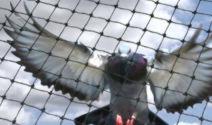Plastic bird netting and pigeon netting is used extensively as a bird exclusion device to protect both buildings and agricultural crops. Plastic bird netting and pigeon netting can be seen on buildings in towns and cities all over the world where it is used as a pigeon exclusion device; farmers also use bird netting extensively to protect valuable fruit crops from attack by wild birds. The main value of plastic pigeon nets in an urban environment where the protection of buildings is concerned is that it will blend in with the fascia of the building and maintain the aesthetic quality of the building concerned. In agricultural environments bird netting is often the only physical exclusion device available to farmers to protect fruit crops, although in many cases the use of netting will be complimented by bird scaring products such as predator balloons and noise-related devices.Plastic bird or pigeon netting is a product that is normally recommended for home installation, due to the complexity of the installation and the wide range of tools and materials required to achieve a lasting installation. It will generally be necessary to engage a specialist contractor to undertake a home installation unless the area to be protected is small and the property owner is prepared to research the process and identify a source of the products required. With the advent of the internet, bird nets, pigeon nets and associated products are more widely available to property owners and it is possible to source the products with relative ease.Plastic bird or pigeon netting is manufactured to withstand a wide range of weather and environmental conditions. The product is chemically inert, will not rot nor absorb water and is UV protected. These factors ensure that in optimum conditions and assuming that the netting has been installed and maintained according to manufacturers’ recommendations and using a corrosion-resisting suspension system, plastic bird netting has a working life of 10 years or more according to one UK distributor.Installing bird or pigeon netting in a bird proofing application is a potentially complex operation and must be well thought through prior to starting work. In many cases bird netting is provided at height and often in areas that are difficult to access, so it is important to ensure that specialist access equipment is available such as a scissor lift or ‘cherry picker’. Health and safety is also a major consideration and if a ‘home’ installation is being undertaken a thorough risk assessment should first be carried out.
The basic principle of protecting a building with bird netting or pigeon netting is to completely exclude the target species from the netted area. To achieve this goal the netting has to be installed as per manufacturer’s recommendations and to an extremely high standard. The netting is held in place by a suspension system that involves the provision of highly tensioned steel or stainless steel wire rope around the periphery of the area to be protected. Once the wire has been installed and tensioned the netting is then attached to the wire by retaining clips called ‘hog rings’. The netting is pulled tight and square prior to the final retaining clips being installed. The netting is then checked to ensure that there are no gaps large enough for the target species to enter the netted area and this completes the installation.Plastic bird nets and pigeon nets are available in a variety of different colours including black, ‘stone’ and translucent. A range of colours are offered for bird proofing applications in order that the net will blend in with the fabric of the building concerned. The best colour used to protect buildings is black because its barely visible from a vantage point of only a few metres if the product has been installed and maintained according to manufacturer’s recommendations. Most types of nylon bird netting and pigeon netting that are used for bird proofing work are made from either polyethylene or polypropylene that has been stabilized against ultra violet light. The most common type of netting used for bird proofing is polyethylene UV stabilized net with a 12/6 twine. Many companies now offer fire-retarded net as standard. Although the ‘knotted’ type of polyethylene bird net has historically been the most commonly specified net for the purposes of bird proofing work, a new ‘knotless’ multi-strand polypropylene net has been designed which is both lighter and stronger than the ‘knotted’ polyethylene version. Knotless netting is approximately 70% stronger than conventional knotted polyethylene netting and is also 30% lighter. The product typically has a melting point that is nearly 50% higher than knotted polyethylene netting. These factors make the knotless netting cheaper to transport, easier to install and negates the need to pull the net into shape as is required with knotted polyethylene netting. Standard pigeon netting is 0.071” (18034mm) thick comprising of 6 strands that are 0.012” (0.3048mm) thick. The breaking strength of each strand of plastic is 23.6 kg (52lbs). The bursting strength is 22kg (44lbs). The product is highly resistant to most chemicals at standard temperatures and the high temperature range for the product is 100-115 degrees C (210-239 degrees F). Low temperature range is -95 to -110 degrees C (-139 to -166 degrees F). Most plastic bird netting is pre-stretched under 9 tons of tension and is then ‘heat set’. Heat setting involves stretching the net and then injecting steam over it for an extended period of time. This process will stretch the twine and tension all the knots to the point where they will retain their shape throughout the life of the product.Plastic bird and pigeon netting is used to exclude a considerable number of different species of birds including pigeons, gulls, sparrows, starlings etc., with a different gauge of netting being required for each species of bird. For pigeons a 50mm (2”) gauge pigeon net will be required, for gulls 100mm (4”), for sparrows 19mm (3/4”) and for starlings 28mm (1 1/8th”). The different gauges are required to ensure that a) the hole is small enough to physically prevent the target species from entering the netted area and b) if the netting is provided horizontally the target species will not be able to perch or walk on the net. One of the main problems inherent with the use of nylon bird netting and pigeon netting for the protection of buildings is where more than one species is roosting on a building. For example, if a building has been protected against pigeons by using a 50mm pigeon net, starlings would be able to enter the netted area and roost or nest, potentially causing more entrenched problems for the property owner. If, however, a 28mm starling net was provided in a horizontal application so that both species were excluded from the netted area, the mesh size would be small enough for pigeons to walk and perch on it resulting in continued problems for the property owner.Copyright: Edited from Pigeon Control Resource Centre, https://www.pigeoncontrolresourcecentre.org/

